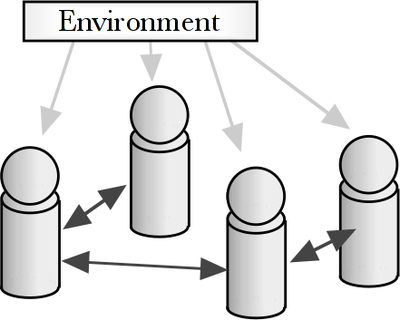Political Participation (1.0.2)
Purpose
Examine whether the description of political participation outlined in Milbrath (1965) is a realistic description of political participation. Milbrath provides an detailed description on how and why individuals participated in politics. The aim here is to check whether the descriptions in Milbrath add up to observed patterns of political participation.
The focus is on the different levels of participation, and not on vote choice and other related concepts. The main test is to check whether the dynamics of political participation occur.
Entities, state variables, and scales
Milbrath’s model of political participation was simplified. There are agents and global variables; patches do not play a role. Agents have individual characteristics, most of which are open to change according to the dynamics of the system. The characteristics are (opposites in square brackets): active [passive], overt [covert], autonomous [compliant], approaching [avoiding], continuous [episodic], outtaking [inputting], expressive [instrumental], and social [nonsocial]. Each characteristic is modelled as a continuous variable. Agents also have a specific socioeconomic status (SES), contacts in the community, and time is tracked to determine the time agents have spent in a community. Political participation is represented in levels, ranging from 0 (apathetic) to 12 (holding office).
Process overview and scheduling
Agents are subject to stimuli with probability p, then interact with other agents with probability q, and then move to another community with probability r. Levels of political participation are updated at the end of each round, assumed to be 1 week. The values of p, q, and r are determined by the political environment (put differently, the political environment is determined by p, q, and r). Agents keep a history of their level of political participation.

Release Notes
Better documentation, checked with NetLogo 6.4
Associated Publications
Ruedin, D. 2005. “A Simulation of Political Participation.” MSc Thesis. Oxford University.
Ruedin, D. 2007. “Testing Milbrath’s 1965 Framework of Political Participation: Institutions and Social Capital.” Contemporary Issues and Ideas in Social Sciences 3(3).
Ruedin, D. 2011. “The role of social capital in the political participation of immigrants: Evidence from agent-based modelling.” SFM Discussion Paper 27.
This is a companion discussion topic for the original entry at https://www.comses.net/codebases/4180/releases/1.0.2